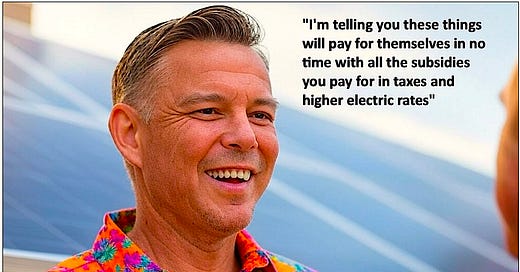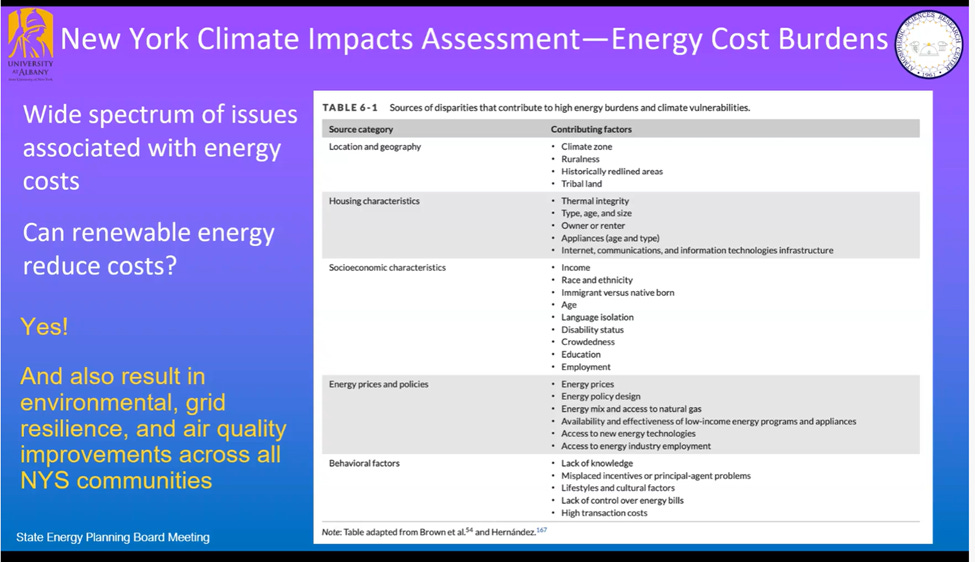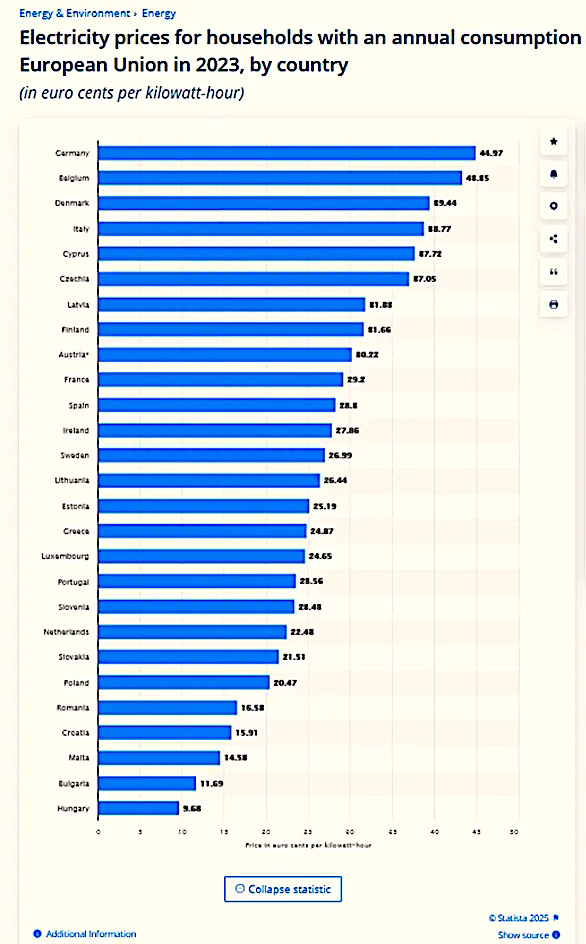Renewables Are No Way Cheaper, and This Reality Can No Way Be Hidden Any Longer (Even in New York)
Guest Post by Roger Caiazza of Pragmatic Environmentalist of New York.
I have run into a couple of instances where New York Climate Leadership & Community Protection Act (Climate Act) proponents have claimed that renewable energy development can reduce costs. This article responds to the argument that reduced fuel price volatility will make renewables cheaper.
Renewable Energy Can Reduce Costs
I am disappointed that the ‘renewable energy can reduce costs’ claim has made it into the New York State Energy Plan process. The Energy Plan is “a comprehensive roadmap to build a clean, resilient, and affordable energy system for all New Yorkers.”
When the Energy Planning Board met on March 3, 2025 to adopt the scope for the state energy plan this claim was mentioned. One item on the agenda was a discussion of the “planned approach for techno-economic pathways analysis.” This is the analysis work whereby the state agencies and their consultants will “prove” their pre-conceived notion that the Climate Act net-zero transition concocted by politicians will work.
The presentation by Jeff Freedman from the Atmospheric Sciences Research Center, University at Albany, Albany, New York included the following slide that makes the claim that renewable energy can reduce costs. One characteristic of the New York State Energy Research & Development Authority (NYSERDA) documentation for the implementation plan is inadequate documentation, so it is not surprising that the justification for the claim is not readily available.
Table 6-1 was in New York State Climate Impacts Assessment Chapter 06: Energy. That chapter, in fact, does not address renewable energy costs specifically. I searched for references to costs in it and found only one relevant reference on page 370:
Energy costs: Fossil fuel prices are increasingly volatile, largely because they are traded on global markets. In contrast, a power sector composed of large volumes of renewable resources that have no fuel costs could lead to less volatile energy bills due to the elimination of this driver of variability in energy costs. The presence of distributed resources amplifies this effect. Whether the costs of a clean power sector are lower than, comparable to, or higher than the status quo, they will be more predictable and less likely to create indirect costs that arise from unexpected price changes.
I am aware of only one other instance where this rationale was mentioned.
The December 18, 2024 New York Assembly Committee on Energy public hearing enabled legislators to question NYSERDA and the New York State Department of Public Service (DPS) staff about Climate Act progress. When Jessica Waldorf, Chief of Staff & Director of Policy Implementation, DPS was asked what impact Climate Act GHG emission reductions would have given that New York emissions are smaller than the observed annual increases in global GHG emissions. Waldorf said that there are other reasons “to build renewable energy resources in New York that are not just related to emissions.” She gave two reasons: energy security and price volatility.
The other thing I would say about energy security is price volatility. Customers are beholden to the whims of the fossil fuel industry and the up and down markets that we see from fossil fuels. Localizing our energy production and renewables allows us for price stability. That is definitely a benefit of building resources here.
The presumption in this article is that renewable energy will be cheaper and less volatile in that a renewable energy dependent electric system will have less unstable fuel costs, resulting in cheaper and more secure energy. This, in turn, is based on two presumptions: fuel prices are volatile because of global markets and renewables would eliminate this cost driver.
Fuel Volatility
The US Energy Information Administration (EIA) noted in June 2024 that fossil fuel price volatility has shown significant changes over time, with recent years experiencing particularly high levels of volatility:
“In 2022, natural gas price volatility reached extreme levels, with historical volatility peaking at 171% in February 2022, the highest since at least 1994.”
Note the EIA is only discussing natural gas volatility, which has become a much larger electric generating fuel source in recent years. In my opinion, the increasing reliance on a single fuel could be the fundamental reason for the observed increase in volatility.
In any case, the New York agency global market argument picks just one driver for fuel price volatility. The EIA gave other reasons for natural gas variability in August 2022:
Increased uncertainty about market conditions that affect natural gas supply and demand can result in high price volatility. Events that have contributed to changing market conditions include:
Storms
Unplanned pipeline maintenance and outages
Significant departures from normal weather
Changes in inventory levels
Availability of substitute fuels
Changes in imports or exports
Other sudden changes in demand
U.S. natural gas prices are typically more volatile during the first quarter of a year because of the fluctuating demand for natural gas for space heating as weather changes. Factors that contributed to heightened volatility in the first three months of this year include:
Declines in Lower 48 states’ working natural gas levels
Record U.S. LNG exports to Europe to help offset reduced natural gas supplies from Russia
Of the eight events that contribute to changing market conditions and fuel volatility, imports and exports is the only one related to global market conditions.
Jurisdictional Proof
When I get around to submitting a comment on the weakness of this argument, I intend to demand that the proponents of the Climate Act offer an example of a jurisdiction where the electric system has become reliant on wind and solar renewable generation and consumer costs have gone down because fuel volatility has decreased. To my knowledge, all jurisdictions have seen consumer cost increases.
I used Perplexity AI to research electric energy prices as a function of wind and solar deployment. My experience showed the weaknesses of AI research. The response to the question, of whether consumers in any jurisdiction have seen decreased costs when transitioning their electric system to rely on wind and solar, was a claim it was true. The response said:
“This trend is driven by the rapidly declining costs of renewable energy technologies and their increasing cost-competitiveness compared to conventional fossil fuel sources.”
The reference cited was from Ember-Energy “a global energy think tank that accelerates the clean energy transition with data and policy” that can hardly be considered an unbiased source!
The response also does not address consumer rate costs. It makes the mistaken claim that the cost of developing renewable technologies has little relation to the delivered cost of electricity to consumers.
In the real world, the cost of storage to address intermittency, the cost of additional transmission support to address diffuse wind and solar, and the cost to provide the ancillary transmission support services not available from wind and solar, make renewables much more expensive than fossil fuels. I was unable to frame a question that provided an answer that acknowledged that the costs necessary to provide consumers with reliable power made delivered renewable energy more expensive.
German Experience
However, if the claim is true then proponents should be able to point to jurisdictions where wind, solar, and energy storage have make electric prices cheaper.
The best example of the claim that renewable energy is cheaper because it reduces fuel volatility should be Germany. Oil, coal and gas prices spiked in the immediate aftermath of Russia’s invasion of Ukraine and have been volatile ever since. Germany’s Energiewende is the country’s planned transition to a low-carbon, nuclear-free economy and is often cited as an example of what New York should do. Enerdata reports that “According to the German Federal Network Agency, the installed renewable power capacity in Germany increased by nearly 20 GW (+12%) to nearly 190 GW in 2024.”
If the proponent’s claim is true then prices should be trending down. However, since 2000, electricity prices for German households have risen by 116%, from 13.94 to 30.43 cents per kilowatt-hour in 2019 . As of April 1, 2024, households with basic supplier contracts were paying around 46 cents per kilowatt-hour, making it “the most expensive option compared to other providers or special contracts” .
Another way to look at the claim is to compare electricity prices within the European Union. I highly recommend the Nemeth Report for its coverage of European energy issues. The post EU Action Plan for Affordable Energy includes just such a comparison. It quotes Ursula von der Leyen, President of the European Commission, as saying: “We’re driving energy prices down and competitiveness up. We have already significantly reduced energy prices in Europe by doubling down on renewables. “
However, the data in the following figure do not support her claim.
The analysis states that:
Note that the household price average shows a large difference between EU countries that use coal, nuclear, and gas vs those that have focused on wind and solar. For example, as shown in the chart above, according to Statista, using 2023 data, Hungary’s electricity price was 9.68 Eurocents/kwh (50% of their electricity is from nuclear, 38% coal & gas) and Bulgaria which relies mostly on coal and nuclear was around 11 Eurocents/kwh, whereas Germany, which has “doubled down on renewables” (and closed down its nuclear), was the highest at 44.97 Eurocents/kwh and Denmark which has a small population and a whole lot of windmills was at 39.44 Eurocents/kwh!
Data sources and the year of the data matters. Eurostat uses numbers from the first quarter of 2024 which reorder some of the countries but the overall argument, that countries that “doubled down on renewables” and made other poor choices of shutting down nuclear power plants and/or coal experienced higher prices, remains supported.
Discussion
Roger Pielke, Jr recently posted an article about the politicization of expertise that is relevant here. He argues that society needs to depend on the expertise of specialists in many fields – “Nobody knows enough to run the government”. As a result, society needs all of us. He explains that “We do not have to agree on everything, but we do have to work together”. Then he points out that “In recent years, credential expertise—like many things—has become pathologically politicized.”
Such is the case shown by the politicization of the Climate Act implementation led by NYSERDA. Consider, for example, the presentationby Jeff Freedman to the Planning Board. It is concerning on a couple of levels. In the first place, the Planning Board is composed of agency heads and political appointees who for the most part do not have background and experience in the energy sector.
Freedman was presented as an expert from the energy sector whose claim that “renewable energy can reduce costs” was probably taken as the gospel. However, his main research focus is on “renewable energy and atmospheric boundary layer (ABL) processes” so his bias is towards renewable energy virtues and he has no energy sector experience that qualifies him to make such a statement. He was a spokesman because of his adherence to the narrative.
In the second place, the presentations at the meeting suggest that NYSERDA will follow the Scoping Plan approach in the stakeholder process for the Energy Plan. The primary purpose of the meeting was to approve the final scope of the Energy Plan. As was the case with the Climate Act Scoping Plan the NYSERDA response to stakeholder comments is to document the number of comments received by category and provide general descriptions of key themes and “responsive Scope revisions.”
My problem with this is that if anyone provides specific comments or raises specific issues with claims, there is no documentation that the submittal was addressed, and nothing included to respond to the issue raised. For example, the claim that renewable energy can reduce costs was undocumented in Freedman’s presentation.
I have no doubts that NYSERDA will continue the charade that renewable energy can reduce costs and that costs of inaction are worse than the costs of action. They have never responded to related issues raised and will continue to do so as long as they can get away with it. This is another instance of pathologically politicized expertise by NYSERDA because they are so arrogant that they don’t see any need to respond to stakeholder comments.
Conclusion
The biggest threat to Climate Act progress is the inevitable extraordinary cost of implementation. The Hochul Administration has ducked the issue since the Climate Act was passed. They can only hide reality for so long. The question is whether the issues associated with the net-zero transition will be addressed before New York’s economy is severely compromised.
In the meantime, if you ever hear anyone say renewable energy can reduce costs, please ask them why German electric prices are so high or to cite an example of any jurisdiction that is transitioning their electric system that has reduced ratepayer bill costs when using the Climate Act strategy to rely wind, solar, and energy storage resources.
#RenewableEnergy #Caiazza #Climate #NYSERDA #NewYork #ClimateAct #ElectricityCosts #Hochul
Roger Caiazza blogs on New York energy and environmental issues at Pragmatic Environmentalist of New York. This post represents his opinion alone and not the opinion of his previous employers or any other company with which he has been associated. Roger has followed the Climate Leadership & Community Protection Act (Climate Act) since it was first proposed, submitted comments on the Climate Act implementation plan, and has written over 500 articles about New York’s net-zero transition.






